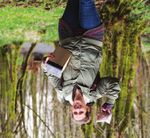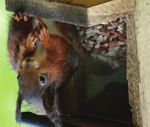Case Study 8 - Scottish Environment LINK
←
→
Page content transcription
If your browser does not render page correctly, please read the page content below
Still Delivering the Goods
ONGOING
Case Study 8
Saving Scotland’s Red Squirrels:
Developing Community Action
Scottish Wildlife Trust
Photo: Raymond Leinster
Read the full report, with the 15 case studies here:
https://www.scotlink.org/publication/still-delivering-the-goods/8
Saving Scotland’s Red Squirrels: Developing Community Action
Scottish Wildlife Trust
Background Saving Scotland’s Red Squirrels – Developing Community Action (SSRS-DCA) is an
innovative partnership project to secure the long-term future of red squirrels in
Scotland by building capacity among communities of volunteers and land managers,
empowering them to take on and take ownership of some of the essential protection
measures required to save the nation’s red squirrels.
The partnership project is led by the Scottish Wildlife Trust, and includes NatureScot,
Scottish Forestry, Scottish Land & Estates, Red Squirrel Survival Trust and RSPB
Scotland. It is also supported by an extensive network of landowners working under
Forestry Grant Schemes or voluntarily, as well as increasing numbers of volunteers.
Over its first 8 years, SSRS established that it is possible to halt the decline of red
squirrels over a wide area via strategically targeted and co-ordinated landscape-scale
grey squirrel control. The initiative has enabled reds to re-establish in many areas.
Project aims Since 2017, SSRS-DCA has aimed to galvanise communities of volunteers and land
managers to act together to protect red squirrels in their area. In turn this will protect
and enhance the legacy of increased red squirrel populations brought about by the
work to date of the SSRS project, and enable people to make an important ecological
impact, making the red squirrel population more resilient to changes and safeguarding
important populations for Scotland.
In the current five-year project timeframe, SSRS-DCA aims to:
1 Develop and implement a programme of red squirrel protection capable of securing
the long-term survival of core red squirrel populations across Scotland.
2 Recruit and equip communities to take on a vital role in the long-term protection
of red squirrels in key areas across the country.
3 Protect populations of red squirrels across their current “red-only” range north
of the Highland Boundary Fault and in key areas of south Scotland.
4 Manage the impact of the Squirrel Pox Virus (SQPV) if it ever reaches the Central
Lowlands.
5 Monitor changes in Scotland’s red and grey squirrel distributions over time.
In addition, SSRS has three different geographical regions of operation, each with its
own aims:
> In Aberdeen City and Aberdeenshire, the aim is to progressively reduce occupancy
and abundance of grey squirrels with a long-term goal of eradication. The aim here
is to develop a “rapid response methodology” to detect and respond to any
remnant or resurgent populations.
> In Tayside, Stirling and Loch Lomond and the Trossachs, the aim is to prevent the
northward spread of grey squirrels and squirrelpox, through a programme of
targeted grey squirrel control coast to coast along the Highland Line.
> In South Scotland, the aim will be to mobilise communities and landowners to act
together to protect red squirrels in priority areas area, fostering a sense of
ownership and pride in their role in the conservation of this charismatic species.8 Saving Scotland’s Red Squirrels: Developing Community Action
Scottish Wildlife Trust
Project The current NLHF supported phase of the project (Saving Scotland’s Red Squirrels
Timescale – Developing Community Action) runs from 2017–2022.
SBS
The aims from the 2020 Challenge for Scotland’s Biodiversity:
Objectives To protect and restore The protection of red squirrels, a key
1 biodiversity on land and iconic species in Scotland, and
and in our seas, and enabling its expansion by the control of
to support healthier the invasive grey squirrel is clearly working
ecosystems. to protect and restore biodiversity.
To connect people The focus of this project is to achieve
2 with the natural world, its biodiversity objectives through
for their health and well- developing community and land
being and to involve manager actions. This ensures
them more in decisions widespread connection with nature
about their environment.. and involvement in the management
of their environment.
To maximise the Although not a direct and explicit
3 benefits for Scotland objective, a healthy and growing red
of a diverse natural squirrel population helps support
environment and the tourism as such an iconic species. In
services it provides, addition, as an indicator of sustainable
contributing to sustainable woodlands, the red squirrel is also an
economic growth. indicator of a healthy forestry sector.
Project Saving Scotland’s Red Squirrels focuses on working with local communities to improve
Summary conditions for native red squirrels across Scotland by combatting the spread of the
invasive grey squirrel.
While 75% of the UK’s remaining red squirrels are found here, their numbers have fallen
drastically in the decades prior to SSRS to just 120,000. This is largely due to the spread
of the non-native grey squirrel, which was introduced from North America by people in
the late 1800s. Grey squirrels also carry squirrelpox, a virus that does not harm them
but is deadly to reds. With the help of partners, landowners and local volunteers, the
project is monitoring squirrel distributions across Scotland, managing the impact of
squirrelpox, and combatting the spread of grey squirrels in strategic areas.
Climate The project has little direct benefit for climate. However, as an indicator of healthy
Impacts woodlands, red squirrels are a totemic species – whose conservation encourages the
better management and expansion of mixed-age forests and native woodland.
The project should, therefore, be seen as a key part of efforts to restore and expand
Scotland’s woodlands – and ensure they are managed well.8 Saving Scotland’s Red Squirrels: Developing Community Action
Scottish Wildlife Trust
From Left to Right: Jo Foo Wildlife Photography, Jaclyn Sparks, Jo Foo Wildlife Photography, Raymond Leinster
People Direct employment:
Information
> 29 individuals (25.3 FTE) employed in 2021; while several core Scottish Wildlife
Trust staff roles also contribute a proportion of their time to the project.
Volunteers:
> Over 3,000 volunteer-days since 2017.
> 1,077 volunteers registered on the SSRS on-line Community Hub (and many
more who choose not to register).
Wider engagement:
> 315 public engagement talks, walks, stall events, training events, press and media
events and stakeholder meetings delivered over the last 4 years: and over 500
individual volunteer support or training sessions.
Successes and
> The SSRS partnership project has established that it is possible to halt the decline
achievements
of red squirrels over many years and over a wide area and enable red squirrels
to re-establish in many areas, via strategically targeted and co-ordinated
landscape-scale grey squirrel control.
> The SSRS-DCA project has built specialised on-line Community Hub linked to the
project website to provide ongoing data capture and management, enabling
volunteer groups to manage their own data and efforts, as well as providing training,
support, feedback, monitoring to volunteers.
> Between 2011 and 2019 SSRS has delivered 9 successive annual systematic surveys,
delivered by volunteers, to enable comparative measures of impact of project work
on red and grey squirrel distributions.
> The squirrel sightings reporting facility has enabled citizen science to contribute
to the long-term monitoring of red and grey squirrel distributions.
Issues and The key issues facing the Trust and project team have been:
challenges > The Covid-19 pandemic and the limitations it has placed on squirrel control work,
monitoring and public engagement.
> The high level of resource demand, especially staff time, to deliver the project.
This raises an ongoing and a future funding challenge.
> The challenge of who will take the project forward, and in what form – especially
as ending the interventions risks a reversal of fortune for the red squirrels.
Funding This current phase of the project has a budget of £3,629,293 with the National Lottery
Heritage Fund providing a grant of £2,464,100. The remaining funding has come
through a wide range of organisations and individuals.
Further https://scottishsquirrels.org.uk/about/
informationYou can also read























































